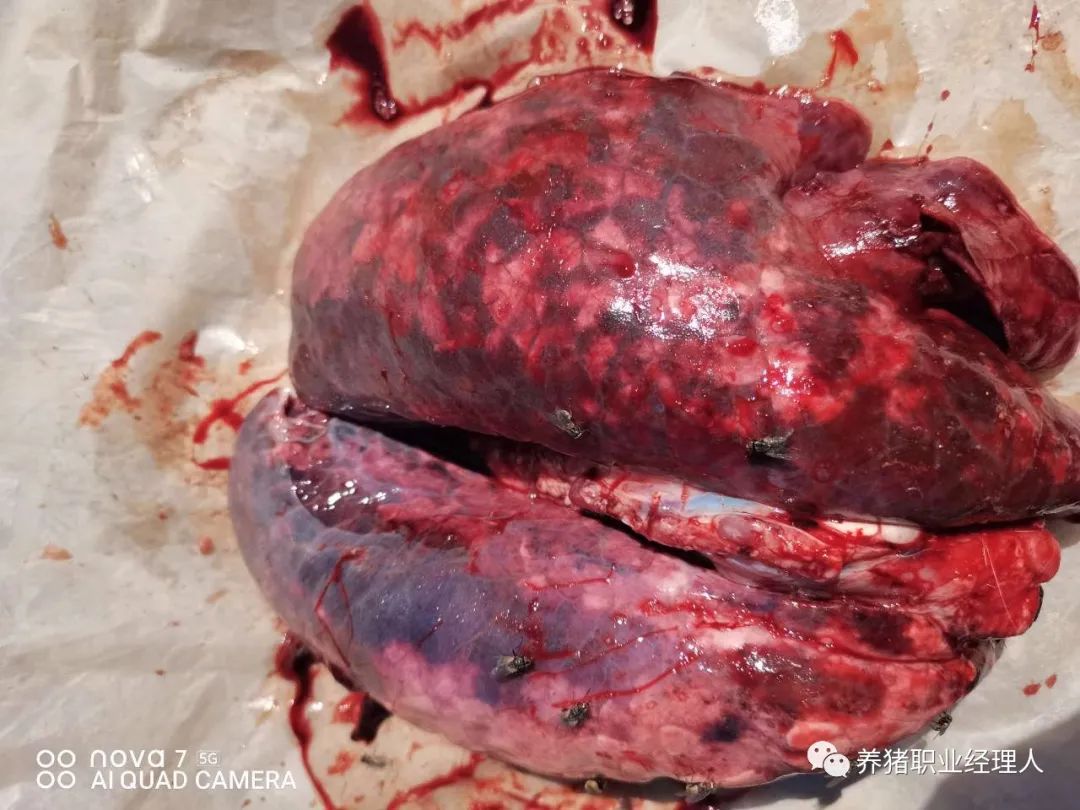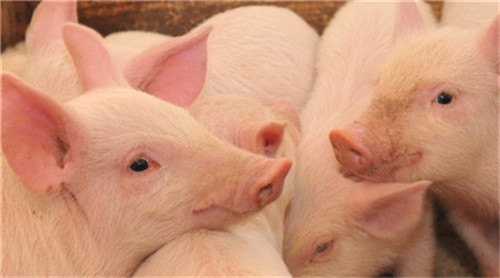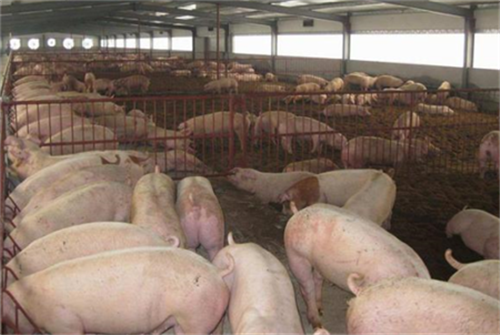Role Analysis of Respiratory tract pathogenic microorganisms in Pig Farm (part two)
The door opener of respiratory syndrome: Mycoplasma hyopneumoniae
Mycoplasma first combined with the cilia of porcine respiratory mucosal epithelial cells and then migrated in the respiratory tract, resulting in a decrease in ciliary function, unable to effectively remove fragments and invasive pathogens in the respiratory tract, and then led to the evolution of the lungs into a virus bank and bacteria bank.
Mycoplasma hyopneumoniae existed in the nasal cavity of infected pigs with an incubation period of 10-14 days. No pathological changes were found in piglets under 2 weeks of age. However, if severe changes in the nasal microenvironment are caused by atrophic rhinitis at the production site, the clinical symptoms of Mycoplasma hyopneumoniae will be shown in advance in the delivery room.
The initial clinical symptom of the disease is a chronic dry cough without sputum, which is usually most obvious in the morning and when disturbed, or when forced exercise. Once the cough is dry, the mucous membrane of the whole respiratory tract is slightly congested, the microenvironment in the respiratory tract is broken, and the mucosal damage is aggravated, which in turn promotes the secondary occurrence of type D Pasteurella multocida, which in turn leads to more serious atrophic rhinitis and promotes each other. At the same time, the respiratory tract environment caused by piglet dry cough is unstable, which makes the settlement bacteria (parasigs, streptococcus, Pasteurella multocida, etc.) become extremely active and begin to multiply in large numbers, which lays a hidden danger for the incidence of settlement bacteria. The first to bear the brunt is Pasteurella multocida. Mycoplasma infection is often accompanied by secondary Pasteurella multocida type A, resulting in Pasteurella multocida pneumonia, aggravating the severity of pneumonia and leading to more extensive lung lesions.
Fibrous tissue adhesion, necrotic area and abscess could be seen on the surface of the lung and the inner wall of the chest. The clinical manifestation of pigs changed from chronic dry cough to wet cough.
To sum up, Mycoplasma can cause changes in the microenvironment in the respiratory tract, which provides the necessary conditions for the mass reproduction of other respiratory tract bacteria. At the same time, it causes a decline in the resistance of the tonsil, which virtually opens the "internal door" of the tonsil, resulting in unbridled invasion of pseudorabies virus and so on.
"igniter" of respiratory syndrome:
Parasuis, Streptococcus, Actinobacillus pleuropneumoniae
The change of the environment in the respiratory tract causes the instability of pathogenic microorganisms in the respiratory tract, at the same time, strong dry cough also reduces the resistance of tonsil and changes the living place of settled bacteria. At this time, if you add some conditional factors, it will easily cause the occurrence of parasigs and streptococcosis. At this time, Haemophilus parasuis and Streptococcus suis will become "igniters", blue ears, circovirus this "time bomb" once ignited, there will be respiratory disease syndrome.
Haemophilus parasuis can usually be isolated from nasal secretions and tracheal mucus of healthy pigs, meaning that Haemophilus parasuis preferentially migrates in the sinuses and trachea rather than in the tonsils.
Early infection of Bordetella bronchisepticum in the nasal cavity can enhance the migration of Haemophilus parasuis, leading to a guess that mucosal injury may increase the chance of bacterial invasion.
The natural infection sites of Streptococcus suis are upper respiratory tract (especially tonsil and nasal cavity), reproductive tract and digestive tract of pigs. The carrying rate of pigs is close to 100%, which is a conditional pathogen. The inducement of disease can be divided into three categories:
First, a series of skin wounds, including tooth cutting, tail cutting, umbilical cord cutting, castration, burr of feeding equipment, parasites making "tunnels" on the skin, etc.
Second, stress, including a series of stress problems, such as sudden changes in temperature in autumn and winter, water splashing on the high bed during hurdling, excessive humidity, poor ventilation, improper refueling and crowding caused by high feeding density.
Third, the health of pigs, including whether there are immunosuppressive factors in pigs, whether there are mixed infections of other pathogens, and so on.
Therefore, under the initiation of blue ear and circovirus and with the assistance of the change of management conditions, once parasigs and streptococcosis occur, it will promote the disease to occur in the direction of syndrome, and pigs in the conservation stage will show post-weaning multiple system exhaustion syndrome (PMWS).

Actinobacillus pleuropneumoniae can colonize in tonsil and adhere to alveolar epithelium, but there are few bacteria in nasal cavity. As pigs grew up, maternal antibodies against Actinobacillus pleuropneumoniae (APP) gradually disappeared in piglets at the age of 10 weeks. At the same time, chronic dry cough caused by mycoplasma greatly increases the excretion of APP into the environment, causing the rapid spread of the disease. Foam outflow with blood can be seen in the mouth of diseased pigs who died after infection.
Actinobacillus pleuropneumoniae infection can aggravate the severity of pneumonia, pigs from progressive weight loss, pale symptoms to obvious respiratory symptoms, that is, from PMWS to PRDC, thus changing the type of disease syndrome. In most clinical cases, it is difficult to separate PRDC from PMWS because their clinical manifestations are very similar.
The siege trooper of respiratory syndrome: classical swine fever
The phrase "classical swine fever is the source of all diseases" has never changed. When other pathogenic microorganisms cooperatively activate PRRSV and PCV2 to promote the occurrence of disease syndrome, pigs with disease syndrome can not enhance the effective immune response to other immunogens, which further reduces the resistance of pigs, and promotes the occurrence of a variety of disease syndrome in pigs at the same time, the use of drugs is effective, but easy to rebound, there is a symptom rather than a permanent cure. In the later stage of disease syndrome, some pig farms that are not scientifically immunized with classical swine fever vaccine or not immunized with classical swine fever vaccine can easily evolve the state of chronic classical swine fever into a typical state of classical swine fever. At this time, a large number of pigs will die and the use of antibiotics is ineffective. Only emergency classical swine fever vaccine can control the process of the disease.
Therefore, if the circle and blue ears are compared to the "time bomb" of the pig farm, then classical swine fever is the "siege soldier" of disease syndrome. All in all, when any pig farm has an unusually high mortality rate, classical swine fever is indispensable, so many pig farms with heavy casualties are often pig farms that pay little attention to the prevention and control of classical swine fever.
For production managers, various steps should be taken scientifically to control the occurrence and spread of respiratory system disease syndrome and reduce its harm to the health and production performance of pigs. Because the immune system of pigs is the target of PRRSV and PCV2, the infection pressure of PCV2, PRRSV and other pathogens can be reduced by improving feeding management, and the addition of drugs and vaccination can provide significant protection to pigs. In the prevention and control of diseases, we should pay attention to the causes of disease, and try to avoid the occurrence of these causes. The occurrence of the disease is caused by the accumulation of mistakes in many links, so to prevent and control respiratory syndrome, we need to carefully find the mistakes in each link, and improving these mistakes is the best policy.
Related
- On the eggshell is a badge full of pride. British Poultry Egg Market and Consumer observation
- British study: 72% of Britons are willing to buy native eggs raised by insects
- Guidelines for friendly egg production revised the increase of space in chicken sheds can not be forced to change feathers and lay eggs.
- Risk of delay in customs clearance Australia suspends lobster exports to China
- Pig semen-the Vector of virus Transmission (4)
- Pig semen-the Vector of virus Transmission (3)
- Five common causes of difficult control of classical swine fever in clinic and their countermeasures
- Foot-and-mouth disease is the most effective way to prevent it!
- PED is the number one killer of piglets and has to be guarded against in autumn and winter.
- What is "yellow fat pig"? Have you ever heard the pig collector talk about "yellow fat pig"?



